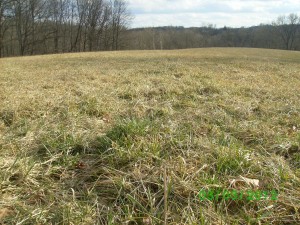– Chris Penrose, Extension Educator, Agriculture & Natural Resources, Morgan Co.
When we think of extending the grazing season, we usually think of how long we can go into the fall or winter without feeding stored feed. Another option often overlooked is how soon we can stop feeding as spring approaches.
Over the years, there has been a lot of discussion on how early we can turn livestock out on pasture and often it depends if you are looking from the forage or livestock perspective (or if you are out of hay). If you have a healthy, productive pasture, you can turn out livestock as soon as the grass starts to green up (in Southeast Ohio, it is usually around the first day of spring). If you use rotational grazing, you can use a fast rotation or open up all the paddocks until the grass really takes off in early April, then start rotational grazing.
Another strategy is to stockpile and graze hay fields. Each year, you can stockpile a field (set it aside to grow from the end of summer through the fall). Tall fescue is the best species to stockpile. For me, I let it set until calving season starts in early March. If the cows are in good condition, the only feed they will get is the stockpiled fescue and a good salt/mineral mix. There are four advantages to this. First, there will be a clean, thick sod to calve on. Second, according to University of Missouri research, the endophyte levels start dropping in fescue after freezing temperatures, and by the end of January, are low enough that they will not cause problems. Third, if you are trying to introduce new species into a predominately fescue sod, grazing down in March (or anytime in the winter) and even exposing the soil will make it ideal for frost seeding and allowing other grasses and clovers to germinate. Finally, it is nice not to have to feed any more hay.
Early grazing hay fields may be an option. It seems no matter how hard we try, many years we just can’t get hay made until June (some are having success wrapping high moisture bales in May). If we have hay fields that were not grazed last fall, the option of turning them out in early March has worked. Try to estimate how much forage is available, the needs of the animals, minus estimated waste, to figure how many days are available. Then turn out the animals in March and try to have the animals finish the hay fields when the pastures start growing. Most years this will work. Last year I had to feed hay for five days in early April as the cattle got ahead of the pasture, but in many years, you could finish feeding hay in early March.
Another advantage to early grazing hay fields is if you can’t get hay made until June, early grazing will set back the hay a little and you will have a higher quality first cutting. Finish early grazing of hay fields in mid to late April, prior to stem elongation, and yield loss on the hay fields will be minimal.
I turned cattle out on a stockpiled field on Saturday, March 3rd for calving season and the grass was the greenest for early March that I have seen it in my 30 years of raising cattle. There should be plenty to graze until the other paddocks are ready for a fast rotation by the end of March.

